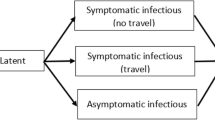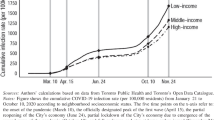Abstract
The COVID-19 epidemic has unleashed a trail of health and economic destruction since the first infected patient was reported in Wuhan, China in late 2019. While this disease is seemingly not as deadly compared to SARS, Ebola, or MERS, it is an exceptionally virulent plague. Evidence has suggested that certain segments of the population and environmental attributes are more vulnerable. Specifically, the elderly people and those with pre-existing medical conditions reported the highest morbidity from COVID-19 infection. Places that are densely populated, with voluminous human traffic, and fleeting social interactions are ostensibly most conducive for viral transmission. Geospatial networks with high centrality and transitivity such as public transportations, leisure and recreational spaces, and workplaces, are locations most susceptible to COVID-19. In response to this epidemic, Singapore entered into a lockdown to curb the spread. All but essential workers such as those in healthcare, public services, and critical supply chains, were required to work from home and minimize interpersonal contact. This study aims to understand local vulnerability by introducing changes of risks and human mobilities across space and time. The study develops a socio-ecological framework of epidemiology using a set of social, built, and spatial features known to influence disease transmission. Subzones with higher integrated vulnerabilities could receive greater epidemiological attention and support in future pandemics.
Access this chapter
Tax calculation will be finalised at checkout
Purchases are for personal use only
Similar content being viewed by others
Notes
- 1.
About 10 subzones make up a planning area, a broader division of regional towns with about 70,000 to 100,000 residents.
- 2.
A “coffee shop” is colloquial term that refers to a place that offers dine-in food, drinks and a place where people gather to interact.
- 3.
Moving distance parameter for sensitivity analysis is different from Table 6.2 as it was meant to measure a more active radius of mobility and interactions.
References
Adger, W. N. (2006). Vulnerability. Global Environmental Change, 16, 268–281. https://doi.org/10.1016/j.gloenvcha.2006.02.006.
Bogich, T. L., Funk, S., Malcolm, T. R., Chhun, N., Epstein, J. H., Chmura, A. A., et al. (2013). Using network theory to identify the causes of disease outbreaks of unknown origin. Journal of the Royal Society, Interface, 10, 20120904.
Bratman, G. N., Hamilton, J. P., & Daily, G. C. (2012). The impacts of nature experience on human cognitive function and mental health. Annals of the New York Academy of Sciences, 1249, 118–136. https://doi.org/10.1111/j.1749-6632.2011.06400.x.
Chin, W. C. B., & Bouffanais, R. (2020). Spatial super-spreaders and super-susceptibles in human movement networks. Scientific Reports, 10, 18642. https://doi.org/10.1038/s41598-020-75697-z.
Cutter, S. L. (1996). Vulnerability to environmental hazards. Progress in Human Geography, 20(4), 529–39. https://doi.org/10.1177/2F030913259602000407.
Cutter, S. L., Boruff, B. J., & Shirley, W. L. (2003). Social vulnerability to environmental hazards. Social Science Quarterly, 84(2), 242–261. https://doi.org/10.1111/1540-6237.8402002.
Cutter, S. L., Barnes, L., Berry, M., Burton, C., Evans, E., Tate, E., et al. (2008). A place-based model for understanding community resilience. Global Environmental Change, 18, 598–606. https://doi.org/10.1016/j.gloenvcha.2008.07.013.
Flanagan, B., Hallisey, E., Adams, E., & Lavery, A. (2018). Measuring community vulnerability to natural and anthropogenic hazards: The centers for disease control and prevention’s social vulnerability index. Journal of Environmental Health, 80, 34–36.
Gómez, J., & Verdú, M. (2017). Network theory may explain the vulnerability of medieval human settlements to the Black Death pandemic. Scientific Reports, 7, 43467. https://doi.org/10.1038/srep43467.
Huang, C. Y., Chin, W. C. B., Wen, T. H., Fu, Y. H., & Tsai, Y. S. (2019). Epirank: Modeling bidirectional disease spread in asymmetric commuting networks. Scientific reports, 9(1), 1–15. https://doi.org/10.1038/s41598-019-41719-8.
Karaye, I. M., & Horney, J. A. (2020). The Impact of Social Vulnerability on COVID-19 in the U.S.: An analysis of spatially varying relationships. American Journal of Preventive Medicine, 59(3), 317–325. https://doi.org/10.1016/j.amepre.2020.06.006.
Lehnert, E. A., Wilt, G., Flanagan, B., & Hallisey, E. (2020). Spatial exploration of the CDC’s social vulnerability index and heat-related health outcomes in Georgia. International Journal of Disaster Risk Reduction, 46,. https://doi.org/10.1016/j.ijdrr.2020.101517.
Leslie, E., Coffee, N., Frank, L., Owen, N., Bauman, A., & Hugo, G. (2007). Walkability of local communities: Using geographic information systems to objectively assess relevant environmental attributes. Health and Place, 13(1), 111–122. https://doi.org/10.1016/j.healthplace.2005.11.001.
Lewis, D. (2020). Coronavirus in the air. Nature, 583, 510–513.
McMahana, E. A., & Estesb, D. (2015). The effect of contact with natural environments on positive and negative affect: A meta-analysis. Journal of Positive Psychology, 10(6), 507–519. https://doi.org/10.1080/17439760.2014.994224.
Ministry of Health (n.d.). Updates on COVID-19 (Coronavirus disease 2019) local situation. Retrieved July 31, 2020 at https://www.moh.gov.sg/covid-19.
Morawska, L., & Milton, D. K. (2020). It is time to address airborne transmission of COVID-19. Clinical Infectious Diseases, ciaa939. https://doi.org/10.1093/cid/ciaa939.
Mueller, A. L., McNamara, M. S., & Sinclair, D. A. (2020). Why does COVID-19 disproportionately affect older people? Aging, 12(10), 9959–9981. https://doi.org/10.18632/aging.103344.
Nayak, A., Islam, S. J., Mehta, A., Ko, Y. A., Patel, S. A., Goyal, A., et al. (2020). Impact of social vulnerability on COVID-19 incidence and outcomes in the United States. MedRxiv. https://doi.org/10.1101/2020.04.10.20060962.
Petrosillo, N., Viceconte, G., Ergonul, O., Ippolito, G., & Petersen, E. (2020). COVID-19, SARS and MERS: Are they closely related? Clinical Microbiology & Infection, 26(6), 729–734. https://doi.org/10.1016/j.cmi.2020.03.026.
Rufat, S., Tate, E., Burton, C. G., & Maroof, A. S. (2015). Social vulnerability to floods: Review of case studies and implications for measurement. International Journal of Disaster Risk Reduction, 14(4), 470–486. https://doi.org/10.1016/j.ijdrr.2015.09.013.
Schmidtlein, M. C., Shafer, J. M., Berry, M., & Cutter, S. L. (2011). Modeled earthquake losses and social vulnerability in Charleston, South Carolina. Applied Geography, 31(1), 269–281. https://doi.org/10.1016/j.apgeog.2010.06.001.
Schwirtz, M., & Cook, L. R. (2020). These N.Y.C. neighborhoods have the highest rates of virus death. The New York Times. Retrieved May 19, 2020, at https://www.nytimes.com/2020/05/18/nyregion/coronavirus-deaths-nyc.html.
Shannon, C. (1948). A mathematical theory of communication. Bell System Technical Journal, 27(4), 623–656.
Singapore Department of Statistics (n.d.). Geographic distribution. Retrieved Nov 25, 2020, at https://www.singstat.gov.sg/find-data/search-by-theme/population/geographic-distribution/latest-data.
Snyder, B., & Parks, V. (2020). Spatial variation in socio-ecological vulnerability to COVID-19 in the contiguous United States. Retrieved May 19, 2020 http://doi.org/10.2139/ssrn.3587713.
Tatem, A. J., Rogers, D. J., & Hay, S. I. (2006). Global transport networks and infectious disease spread. Advances in Parasitology, 62, 293–343. https://doi.org/10.1016/S0065-308X(05)62009-X.
Yonker, L. M., Neilan, A. M., Bartsch, Y., Patel, A. B., Regan, J., Arya, P., et al. (2020). A.Pediatric severe acute respiratory syndrome coronavirus 2 (SARS-COV-2): Clinical presentation, infectivity, and immune responses. Journal of Pediatrics, 227, 45–52. https://doi.org/10.1016/j.jpeds.2020.08.037.
Zhong, C., Arisona, S. M., Huang, X., Batty, M., & Schmitt, C. (2014). Detecting the dynamics of urban structure through spatial network analysis. International Journal of Geographical Information Science, 28(11), 2178–2199. https://doi.org/10.1080/13658816.2014.914521.
Acknowledgements
The preparation of this manuscript by the second author was supported by Singapore University of Technology and Design (Cities Sector: PIE-SGP-CTRS-1803).
Author information
Authors and Affiliations
Corresponding author
Editor information
Editors and Affiliations
Supplementary Figures
Supplementary Figures
See Fig. S1.
The histograms of: a all local vulnerability values, b–g the local vulnerability values for each month from January to June. All seven sub-plots shared the same set of Jenk’s natural breaks that was calculated based on all local vulnerability values. Jenk’s natural breaks method would generate breaks that aims to minimize the variance within group and maximize the variance between groups. As a result, all the five breaks (excluding the minimum and maximum values) located at the lower point (valley) in the histogram presented in (a). We generated Jenk’s natural breaks on all local vulnerability values so that the six months shared the same set of break values, and thus the results in different months can be compared
See Fig. S2.
The histograms of: a all IV, b–g the IV for each month from January to June. All seven sub-plots shared the same set of Jenk’s natural breaks that was calculated based on all IV. Similar to Figure S1, the Jenk’s natural break values located at the lower points in (a). We generated Jenk’s natural breaks on all IV so that the six months shared the same set of break values, and thus the results in different months can be compared
See Fig. S3.
Rights and permissions
Copyright information
© 2021 The Author(s), under exclusive license to Springer Nature Switzerland AG
About this chapter
Cite this chapter
Leong, CH., Chin, W.C.B., Feng, CC., Wang, YC. (2021). A Socio-Ecological Perspective on COVID-19 Spatiotemporal Integrated Vulnerability in Singapore. In: Shaw, SL., Sui, D. (eds) Mapping COVID-19 in Space and Time. Human Dynamics in Smart Cities. Springer, Cham. https://doi.org/10.1007/978-3-030-72808-3_6
Download citation
DOI: https://doi.org/10.1007/978-3-030-72808-3_6
Published:
Publisher Name: Springer, Cham
Print ISBN: 978-3-030-72807-6
Online ISBN: 978-3-030-72808-3
eBook Packages: Social SciencesSocial Sciences (R0)







